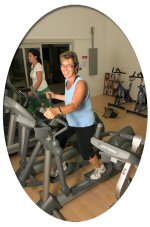


Creating Change > Individual Level: Time >
Making Time for Physical Activity: An Ecological Approach
Making Time for Physical Activity: The Individual 
Interestingly, the lack-of-time barrier to physical activity can be “perceived” (a person believes they have no time) or “real” (a person really does not have extra time). In other words, sometimes, it might feel like there is no time in the day for physical activity, but by adjusting our ideas about what physical activity is or where it takes place, we might find time is more available than it seems.
For example, we often think of physical activity as something that takes place during our leisure time. But what if we accept household chores, walking to work, or taking the stairs instead of the elevator as forms of physical activity? All of sudden, opportunities for physical activity abound.
Strategies
To address the time issue on an individual level, you can encourage clients, members, community members, or employees to
- Find short periods of time, even ten minutes, for physical activity
- Walk up and down the stairs or around the building during a coffee break at work
- Park a block or two from your destination when doing errands, visiting friends, or going to a social or cultural event
- Plan in advance
- For public transit users, leave the house ten minutes early and walk to a bus stop that is further from home
- Bring walking shoes to work and walk during the noon hour
- Set up exercise “dates” with a spouse or a friend
- Incorporate physical activity into a daily routine
Making Time for Physical Activity: The Social Environment
Strategies
Try the following strategies to address the time issue at a social level:
- Provide programming that encourages families to be active together
- Provide/find facilities that can provide child care to reduce the time demands on parents of young children
- Promote a work-place culture that encourages active transportation and active breaks
- Reach individuals who have unconventional schedules by offering programs at a variety of times
- Consult with trained physical activity and health professionals to discuss particular time barriers and how to address them
- Encourage individuals to combine social time with active time (e.g., go for a walk with a friend instead of going for coffee)
Making Time for Physical Activity: The Physical Environment
Strategies
Some strategies for addressing the time issues in the physical environment include:
- Partner with schools to ensure recreational space can be used by the community
- Advocate for safe cycling and walking paths to encourage active transportation to and from school or work
- Advocate for community planning that helps to ensure services are close to one another. For example, it can save time and encourage physical activity if the post office, the grocery store, the bank and the library are all within easy walking distance from one another.
Making Time for Physical Activity: Policies and Regulations
Strategies
Time issues can be addressed by developing policy and implementing regulations. You can contribute at this level by
- Advocating for and working with municipal governments to provide accessible and reliable public transportation
- Advocating for recreational facilities and opportunities in central, residential neighborhoods, not only on the outskirts of a town or city
- Implementing a workplace policy that helps employees deal with time issues (e.g., flexible work hours for employees who actively commute to work or who participate in physical activity during the lunch hours, etc.)
Making Time for Physical Activity: Useful Links
- Barriers to Fitness: Overcoming Common Problems
- Is the Perception of Time Pressure a Barrier to Healthy Eating and Physical Activity Among Women?
- Low Discretionary Time as a Barrier to Physical Activity and Intervention Uptake
- Physical Activity for Busy People
- Shift Workers: Scheduling Self Efficacy and Physical Activity
- Staying Active Every Day
Quick links in Creating Change sectionIndividual Level Social Environment Level Physical Environment Level
|